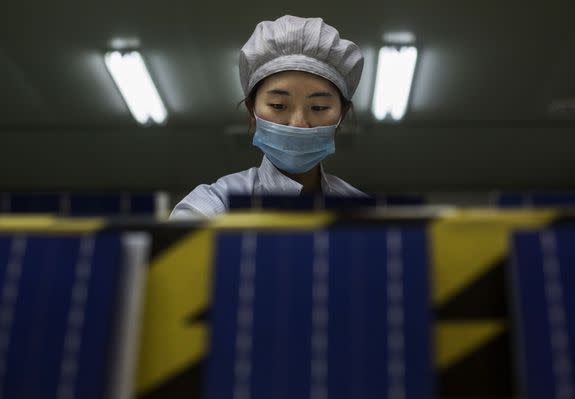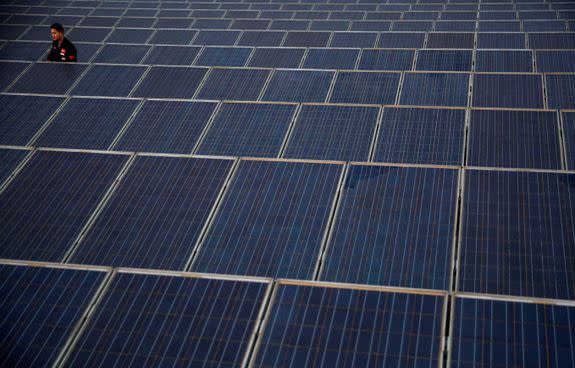Trump's climate order puts 'China first' in clean energy

President Donald Trump is vowing to put "America First" — just not when it comes to the global clean energy race.
The president on Tuesday signed a sweeping executive order that experts say could leave the United States lagging behind China and other nations as manufacturers and investors throw trillions of dollars into renewable energy projects.
The order will start unraveling the Obama administration's key efforts to address climate change. Flanked by coal miners and cabinet officials, Trump vowed to revamp fossil fuel production and erase "job-killing" restrictions on power plants and pipelines.
SEE ALSO: Looking for hope on climate change under Trump? Cities are where the action is.
"Together we are going to start a new energy revolution," Trump said, after outlining his plan that favors centuries-old fuel sources: coal, oil and natural gas. He declined to mention any type of renewable energy, or acknowledge the existence of human-driven global warming.

Image: ron sach-pool/Getty Images
"We will create millions of good American jobs, so many energy jobs, and really lead to unbelievable prosperity all throughout our country," the president claimed.
Trump's executive order kicks off a lengthy process to undo the Clean Power Plan, which curbs carbon emissions from the electricity sector. It also lifts a moratorium on the sale of new coal leases on federally owned land, and it scraps mandates for reducing leaks of methane — a potent greenhouse gas — at oil and gas well sites.
While the U.S. chases fossil fuels, however, China is aggressively rolling out solar plants, wind farms, electric vehicles and other low-carbon technologies. As the world's most populous nation — and the No. 1 emitter of greenhouse gases — China is particularly poised to fill the leadership vacuum that Trump created this week, energy experts said.

Image: REN21
"China sees a strong economic interest in making this transition with regards to air pollution, but also it wants to build an industrial base for clean energy technologies that can dominate the world market," said Paul Bodnar, who oversaw international climate issues at the National Security Council during the Obama administration's second term.
"Chinese leadership is pretty confident this is a long-term, irreversible trajectory toward clean energy, and it creates a big market opportunity that they want to capture," he said.
China's energy agency in January said it would invest 2.5 trillion yuan, or $361 billion, in clean electricity projects by 2020 as part of a broader effort to shift away from coal-fired power plants.

Image: kevin frayer/Getty Images
Although coal has helped drive China's manufacturing growth in the past decade, the facilities have also created a slew of public health crises, including dangerous smog and toxic water pollution. China is now shuttering coal plants near Beijing and has scrapped plans for new ones.
China's National Energy Administration said about half the country's new electricity generation will come from installed solar, wind, hydropower and nuclear projects by 2020 — an effort that should create more than 13 million jobs in the sector.
The United States has also made substantial strides on clean energy, thanks to a wide mix of federal and state policies, private sector investment, and broader market forces — namely the plunging price of natural gas and falling technology costs for solar and wind power.

Image: kevin frayer/Getty Images
In 2015, the U.S. public and private sectors together committed $44.1 billion to the sector. Only China invested more in clean energy, committing $103 billion to renewables that year, according to annual global estimates.
U.S. clean energy jobs have also ticked up. Last year, the nation's solar power workforce grew by 25 percent, to about 374,000 people, compared to 2015, the Department of Energy reported in January. Wind industry employment rose by 32 percent, to 102,000 jobs.
Overall, "low carbon emission" sectors employed about 800,000 workers last year, while 1.1 million people worked in the traditional coal, oil and natural gas industries, the department said.

Image: U.S. Energy information administration
This clean energy progress can still continue under the Trump administration. But the pace could be substantially slower — particularly when compared to renewables-hungry nations like China.
"The U.S. power sector is getting cleaner every year, thanks partly to state and federal policies, but largely to market forces that the Clean Power Plan is designed to accelerate," Bob Perciasepe, president of the Center for Climate and Energy Solutions, via email.
"Withdrawing federal leadership will only jeopardize this promising clean energy transition and the jobs that go with it."
